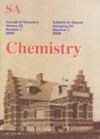表面改性水葫芦与活性炭处理废水的比较研究
IF 1
4区 化学
Q4 CHEMISTRY, MULTIDISCIPLINARY
South African Journal of Chemistry-Suid-Afrikaanse Tydskrif Vir Chemie
Pub Date : 2020-01-01
DOI:10.17159/0379-4350/2020/v73a11
引用次数: 9
摘要
寻找一种经济、高效、易于处理的商业级活性炭(AC)在纺织废水处理中的替代品是迫切需要的。为了解决这个问题,一种有毒的水信子(WH)被探索作为一种“生物吸附剂”,用于脱色废水中的有害纺织染料Remazol Brilliant Red 3BS (RBR 3BS)。采用季铵盐N-十六烷基-N,N,N -三甲基溴化铵对原料WH进行了改性,提高了原料WH的脱色能力。考察了几个工艺参数,即pH、吸附剂用量、温度、浓度和接触时间的影响。通过批量吸附研究、动力学热力学、等温建模和误差分析来确定吸附剂的效果。并与活性炭(AC)进行了比较。在27°C下,表面改性的WH对染料的吸收率最高,为104.26 mg g,是AC的10倍左右。通过等温、动力学和热力学研究,确定了染料-吸附体系的吸附类型。处理后的WH的活化能为8.65 kJ mol, AC的活化能为8.98 kJ mol,证明了表面改性WH在吸附处理中具有较高的替代AC的能力。本文章由计算机程序翻译,如有差异,请以英文原文为准。
Surface-modified Water Hyacinth (Eichhornia crassipes) over Activated Carbon for Wastewater Treatment: A Comparative Account
Finding an economical, efficient and easy handling alternative for commercial grade activated charcoal (AC) in textile wastewater treatment is a dire need. To address this, a noxious weed water hyacinth (WH) has been explored as a ‘biosorbent’ for the decolorization of the hazardous textile dye, Remazol Brilliant Red 3BS (RBR 3BS) in wastewater. A novel surface modification has been carried out using the quaternary ammonium salt, N-Cetyl-N,N,N–trimethyl ammonium bromide, to enhance the dye decolorization capacity of raw WH. The impact of several process parameters, viz. pH, dosage of adsorbent, temperature, concentration and contact time have been examined. Batch adsorption studies, kinetic-thermodynamics, isothermal modelling and error analysis have been studied to ascertain the efficacy of the adsorbent. A comparison of the results has been carried out with activated carbon (AC). Surface-modified WH showed the highest dye uptake of 104.26 mg g, at 27 °C, which was about 10 times more than that of AC. Isothermal, kinetic and thermodynamic studies were conducted for identification of adsorption type taking place for dye–adsorbent systems. Energy of activation was 8.65 kJ mol for treated WH and 8.98 kJ mol for AC. It was proven that surface-modified WH had a high capability to replace AC for adsorption treatments.
求助全文
通过发布文献求助,成功后即可免费获取论文全文。
去求助
来源期刊
CiteScore
3.10
自引率
0.00%
发文量
6
审稿时长
>12 weeks
期刊介绍:
Original work in all branches of chemistry is published in the South African Journal of Chemistry. Contributions in English may take the form of papers, short communications, or critical reviews.

 求助内容:
求助内容: 应助结果提醒方式:
应助结果提醒方式:


